The global haskap berry powder market is valued at USD 432.5 million in 2025 and is set to reach USD 610.1 million by 2035, growing at a CAGR of 3.5%. The haskap berry powder market stands at the forefront of a transformative decade that promises to redefine functional nutrition infrastructure and superfruit enhancement excellence across food processing, nutraceutical manufacturing, health product formulation, and dietary supplement sectors. The haskap berry powder market's journey from USD 432.5 million in 2025 to USD 610.1 million by 2035 represents substantial growth, demonstrating the accelerating adoption of advanced extraction methodologies and sophisticated phytonutrient concentration systems across food applications, health products, nutraceutical formulations, and functional ingredient manufacturing operations.
The first half of the decade (2025-2030) will witness the haskap berry powder market climbing from USD 432.5 million to approximately USD 516.8 million, adding USD 84.3 million in value, which constitutes 47% of the total forecast growth period. This phase will be characterized by the rapid adoption of high-concentration extraction systems, driven by increasing demand for antioxidant-rich formulations and enhanced bioavailability requirements worldwide. Superior anthocyanin retention and polyphenol preservation features will become standard expectations rather than premium options.
The latter half (2030-2035) will witness sustained growth from USD 516.8 million to USD 610.1 million, representing an addition of USD 93.3 million or 53% of the decade's expansion. This period will be defined by mass market penetration of specialized multi-stage processing systems, integration with comprehensive functional food platforms, and seamless compatibility with existing manufacturing and formulation infrastructure.
The haskap berry powder market demonstrates distinct growth phases with varying market characteristics and competitive dynamics. Between 2025 and 2030, the haskap berry powder market progresses through its advanced extraction adoption phase, expanding from USD 432.5 million to USD 516.8 million with steady annual increments averaging 3.6% growth. This period showcases the transition from basic freeze-drying methods to advanced multi-stage concentration systems with enhanced bioactive compound preservation and integrated nutrient stabilization becoming mainstream features.
The 2025-2030 phase adds USD 84.3 million to market value, representing 47% of total decade expansion. Market maturation factors include standardization of extraction protocols, declining processing costs for high-potency powders, and increasing consumer awareness of haskap berry benefits reaching 65-70% effectiveness in functional nutrition applications. Competitive landscape evolution during this period features established manufacturers like Haskapa and BIOHASKAP expanding their product portfolios while new entrants focus on specialized organic certifications and enhanced bioavailability technology.
From 2030 to 2035, market dynamics shift toward advanced customization and multi-sector deployment, with growth accelerating from USD 516.8 million to USD 610.1 million, adding USD 93.3 million or 53% of total expansion. This phase transition logic centers on universal high-potency systems, integration with automated formulation equipment, and deployment across diverse application scenarios, becoming standard rather than specialized ingredient formats. The competitive environment matures with focus shifting from basic concentration to comprehensive bioactive profiles and compatibility with modern food processing operations.
| Metric | Value |
|---|---|
| Market Value (2025) | USD 432.5 million |
| Market Forecast (2035) | USD 610.1 million |
| Growth Rate | 3.50% CAGR |
| Leading Processing Type | Low-Ratio Extraction |
| Primary Application | Food Segment |
The haskap berry powder market demonstrates strong fundamentals with Low-Ratio Extraction systems capturing a dominant share through superior bioactive preservation characteristics and cost-effective processing capabilities. Food applications drive primary demand, supported by increasing functional ingredient requirements and enhanced nutritional profile management solutions. Geographic expansion remains concentrated in developed markets with established superfruit processing infrastructure, while emerging economies show accelerating adoption rates driven by health consciousness trends and rising functional food awareness activity.
Market expansion rests on three fundamental shifts driving adoption across food and nutraceutical sectors. Health consciousness growth creates compelling advantages through haskap berry powder systems that provide comprehensive antioxidant benefits with proven bioactive compounds, enabling manufacturers to develop functional products that enhance nutritional profiles while meeting consumer wellness expectations and justifying premium pricing over synthetic alternatives. Functional food modernization accelerates as companies worldwide seek natural ingredient systems that deliver enhanced nutritional value directly to product formulations, enabling differentiation that aligns with clean-label expectations and maximizes health positioning effectiveness. Consumer awareness increases drive adoption from health-conscious consumers requiring potent superfruit solutions that maximize antioxidant capacity while maintaining natural origin credentials during processing and formulation operations.
However, growth faces headwinds from raw material supply variations that differ across berry harvesting regions regarding availability and quality consistency, potentially limiting production reliability in seasonal harvest categories. Processing complexity also persists regarding extraction optimization and bioactive preservation that may increase manufacturing costs in markets with demanding quality specifications.
The haskap berry powder market represents a compelling intersection of superfruit innovation, extraction technology advancement, and functional nutrition management. With robust growth projected from USD 432.5 million in 2025 to USD 610.1 million by 2035 at a 3.50% CAGR, this market is driven by increasing health consciousness expansion trends, functional food requirements, and nutraceutical demand for potent antioxidant formats.
The haskap berry powder market's expansion reflects a fundamental shift in how food manufacturers and health companies approach superfruit ingredients infrastructure. Strong growth opportunities exist across diverse applications, from food processing operations requiring natural color enhancement to nutraceutical facilities demanding high-potency solutions. Geographic expansion is particularly pronounced in Asia-Pacific markets, led by China (4.7% CAGR) and India (4.4% CAGR), while established markets in North America and Europe drive innovation and specialized segment development.
The dominance of Low-Ratio Extraction systems and food applications underscores the importance of proven processing technology and bioactive reliability in driving adoption. Extraction efficiency and processing complexity remain key challenges, creating opportunities for companies that can deliver consistent potency while maintaining cost efficiency.
Primary Classification: The market segments by processing type into Low-Ratio Extraction, High-Ratio Extraction, Freeze-Dried Processing, and Spray-Dried categories, representing the evolution from basic drying methods to advanced concentration formats for comprehensive bioactive preservation operations.
Secondary Breakdown: Application segmentation divides the haskap berry powder market into Food, Health Products, Nutraceuticals, Cosmetics, and Sports Nutrition sectors, reflecting distinct requirements for potency specifications, particle size, and bioavailability characteristics.
Regional Classification: Geographic distribution covers North America, Europe, Asia Pacific, Latin America, and the Middle East & Africa, with developed markets leading innovation while emerging economies show accelerating growth patterns driven by health awareness programs.
The segmentation structure reveals technology progression from standard freeze-drying methods toward integrated multi-stage platforms with enhanced bioactive preservation and concentration capabilities, while application diversity spans from food manufacturing to pharmaceutical facilities requiring comprehensive antioxidant enhancement and natural ingredient solutions.
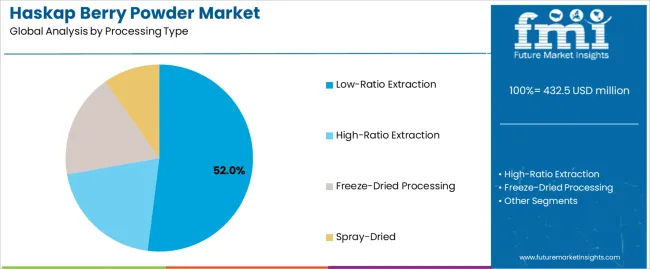
Low-Ratio Extraction segment is estimated to account for 52% of the haskap berry powder market share in 2025. The segment's leading position stems from its fundamental role as a critical component in functional ingredient applications and its extensive use across multiple food and nutraceutical sectors. Low-Ratio Extraction's dominance is attributed to its superior bioactive preservation, including excellent anthocyanin retention, reliable processing consistency, and balanced cost-effectiveness that make it indispensable for everyday functional food operations.
Market Position: Low-Ratio Extraction systems command the leading position in the haskap berry powder market through advanced processing technologies, including comprehensive temperature control, uniform particle formation, and reliable bioactive performance that enable producers to deploy functional ingredients across diverse application environments.
Value Drivers: The segment benefits from manufacturer preference for proven extraction profiles that provide exceptional nutritional density without requiring premium processing costs. Efficient extraction processes enable deployment in food powders, nutraceutical ingredients, and health product applications where bioactive reliability and cost efficiency represent critical selection requirements.
Competitive Advantages: Low-Ratio Extraction systems differentiate through excellent nutrient preservation, proven antioxidant stability, and compatibility with standard processing equipment that enhance functional capabilities while maintaining economical extraction profiles suitable for diverse food manufacturing applications.
Key market characteristics:
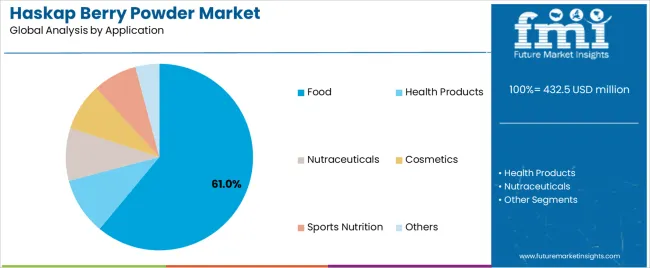
Food segment is projected to hold 61% of the haskap berry powder market share in 2025. The segment's market leadership is driven by the extensive use of haskap berry powder in bakery products, beverage formulations, confectionery applications, and functional food development, where superfruit powders serve as both a nutritional enhancer and natural coloring solution. The food sector's consistent demand for natural ingredients supports the segment's dominant position.
Market Context: Food applications dominate the haskap berry powder market due to widespread adoption of clean-label solutions and increasing focus on functional nutrition, antioxidant enhancement, and natural color alternatives that improve product appeal while maintaining health positioning.
Appeal Factors: Food manufacturers prioritize versatility, color stability, and integration with existing production systems that enable coordinated deployment across multiple product categories. The segment benefits from substantial consumer demand and health trends that emphasize natural ingredient systems for functional food applications.
Growth Drivers: Clean-label initiatives incorporate haskap berry powder as standard components for nutritional enhancement and natural coloring programs. At the same time, consumer health initiatives are increasing demand for premium features that comply with regulatory standards and enhance product differentiation.
Market Challenges: Seasonal supply variations and processing standardization may limit deployment flexibility in ultra-price-sensitive markets or regions with varying quality requirements.
Application dynamics include:
Growth Accelerators: Health consciousness expansion drives primary adoption as haskap berry powder systems provide exceptional antioxidant capabilities that enable functional nutrition without synthetic additives, supporting wellness improvement and product differentiation that require natural superfruit formats. Consumer awareness accelerates market expansion as health-conscious individuals seek potent antioxidant solutions that maintain nutritional benefits during processing while enhancing dietary value through standardized potency and bioavailability. Functional food trends increase worldwide, creating sustained demand for natural enhancement systems that complement health-focused formulations and provide operational advantages in product positioning effectiveness.
Growth Inhibitors: Supply chain volatility challenges differ across berry harvesting regions regarding seasonal availability and quality consistency, which may limit production predictability and cost planning in supply-sensitive manufacturing categories with demanding reliability requirements. Processing complexity persists regarding extraction optimization and bioactive preservation that may increase manufacturing costs in jurisdictions with strict quality protocols. Market education across multiple application segments and processing standards creates compatibility concerns between different formulation systems and existing manufacturing infrastructure.
Market Evolution Patterns: Adoption accelerates in food and nutraceutical sectors where health benefits justify ingredient investments, with geographic concentration in developed markets transitioning toward mainstream adoption in emerging economies driven by health awareness and functional food development. Technology advancement focuses on enhanced extraction methods, improved processing efficiency, and integration with automated formulation systems that optimize bioactive preservation and production consistency. The haskap berry powder market could face disruption if alternative superfruit ingredients or processing technologies significantly challenge traditional haskap berry advantages in functional nutrition applications.
The haskap berry powder market demonstrates varied regional dynamics with growth leaders including China (4.7% CAGR) and India (4.4% CAGR) driving expansion through health consciousness growth and functional food modernization. Steady Performers encompass Germany (4% CAGR), Brazil (3.7% CAGR), and the USA (3.3% CAGR), benefiting from established health product markets and premium ingredient adoption.
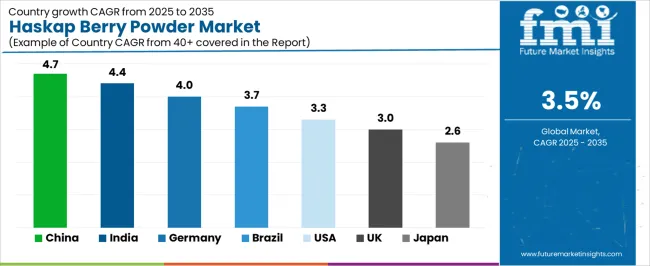
| Country | CAGR (2025-2035) |
|---|---|
| China | 4.7% |
| India | 4.4% |
| Germany | 4% |
| Brazil | 3.7% |
| USA | 3.3% |
| UK | 3% |
| Japan | 2.6% |
Regional synthesis reveals Asia-Pacific markets leading growth through health awareness expansion and functional food development, while European countries maintain steady expansion supported by premium applications and organic certification requirements. North American markets show strong growth driven by nutraceutical demand and health product innovations.
China establishes regional leadership through rapid health awareness development and comprehensive functional food modernization, integrating advanced haskap berry powder systems as standard components in health product formulations and functional food operations. The country's 4.7% CAGR through 2035 reflects population wellness promoting urban health consciousness and nutraceutical infrastructure development that mandate the use of potent antioxidant systems in functional nutrition operations. Growth concentrates in major metropolitan areas, including Beijing, Shanghai, and Guangzhou, where health product networks showcase integrated haskap systems that appeal to wellness companies seeking enhanced nutritional profiles and international superfruit standards.
Chinese manufacturers are developing innovative haskap berry powder solutions that combine local processing advantages with international quality specifications, including multi-stage extraction and advanced bioactive preservation capabilities.
Strategic Market Indicators:
The Indian market emphasizes functional nutrition applications, including rapid wellness development and comprehensive health product expansion that increasingly incorporates haskap berry powder for ayurvedic formulations and natural health applications. The country is projected to show a 4.4% CAGR through 2035, driven by massive health consciousness activity under wellness initiatives and consumer demand for standardized, high-quality superfruit systems. Indian health product facilities prioritize cost-effectiveness with haskap powder delivering nutritional efficiency through economical ingredient usage and reliable bioactive capabilities.
Technology deployment channels include major wellness companies, nutraceutical manufacturers, and functional food developers that support high-volume usage for domestic and traditional medicine applications.
Performance Metrics:
The USA market emphasizes advanced haskap berry powder features, including innovative extraction technologies and integration with comprehensive nutraceutical platforms that manage dietary supplements, functional foods, and health product applications through unified superfruit systems. The country is projected to show a 3.3% CAGR through 2035, driven by health product expansion under wellness development trends and consumer demand for premium, potent antioxidant systems. American health companies prioritize efficacy with haskap powder delivering comprehensive nutritional enhancement through advanced bioavailability and operational innovation.
Technology deployment channels include major supplement brands, health retailers, and functional food developers that support custom development for premium operations.
Performance Metrics:
In Berlin, Munich, and Hamburg, German food manufacturers and nutraceutical operators are implementing advanced haskap berry powder systems to enhance nutritional capabilities and support product innovation that aligns with organic protocols and quality standards. The German market demonstrates sustained growth with a 4% CAGR through 2035, driven by organic certification programs and consumer investments that emphasize natural ingredient systems for functional food and health product applications. German manufacturing facilities are prioritizing haskap systems that provide exceptional bioactive profiles while maintaining compliance with organic standards and minimizing processing complexity, particularly important in premium food manufacturing and nutraceutical facility operations.
Market expansion benefits from clean-label programs that mandate enhanced nutrition in food specifications, creating sustained demand across Germany's food and health sectors, where antioxidant potency and ingredient authenticity represent critical requirements.
Strategic Market Indicators:
Brazil's expanding functional food market demonstrates strategic haskap berry powder deployment, growing at 3.7% CAGR, with documented nutritional excellence in health beverages and functional food applications through integration with existing tropical fruit processing systems and quality manufacturing infrastructure. The country leverages agricultural expertise in fruit processing and powder production to maintain market growth. Manufacturing centers, including São Paulo, Rio de Janeiro, and Brasília, showcase advanced installations where haskap powder systems integrate with comprehensive functional food platforms and processing systems to optimize nutritional enhancement and operational efficiency.
Brazilian food manufacturers prioritize ingredient versatility and cost effectiveness in product selection, creating demand for adaptable haskap powder systems with diverse applications, including functional beverages and integration with tropical fruit processing protocols. The haskap berry powder market benefits from established food processing infrastructure and willingness to invest in specialized superfruit technologies that provide superior nutritional properties and export compliance.
Market Intelligence Brief:
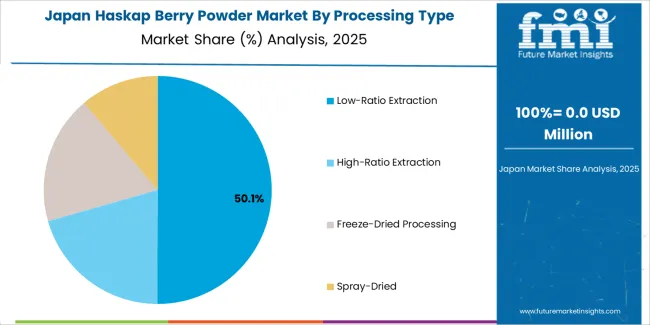
Japan's sophisticated functional food market demonstrates meticulous haskap berry powder deployment, growing at 2.6% CAGR, with documented operational excellence in health supplements and premium food applications through integration with existing quality assurance systems and manufacturing infrastructure. The country leverages engineering expertise in food processing and ingredient purification to maintain market leadership. Manufacturing centers, including Tokyo, Osaka, and Nagoya, showcase advanced installations where haskap powder systems integrate with comprehensive health platforms and processing systems to optimize nutritional delivery and operational efficiency.
Japanese health companies prioritize ingredient purity and bioactive consistency in product selection, creating demand for premium haskap powder systems with advanced features, including ultra-high concentration and integration with automated filling protocols. The haskap berry powder market benefits from established health infrastructure and willingness to invest in specialized superfruit technologies that provide superior antioxidant properties and regulatory compliance.
Market Intelligence Brief:
The UK market emphasizes premium haskap berry powder applications, growing at 3% CAGR, with focus on organic health products and premium functional foods through integration with established quality certification systems and retail distribution networks. British health companies prioritize ingredient traceability with haskap powder delivering comprehensive nutritional profiles while maintaining organic compliance and premium positioning that appeals to health-conscious consumers seeking verified superfruit benefits.
Manufacturing expansion benefits from premium positioning programs that emphasize natural ingredients in health specifications, creating sustained demand across the UK's health and premium food sectors.
Performance Metrics:
The haskap berry powder market in Europe is projected to grow from USD 89.3 million in 2025 to USD 125.7 million by 2035, registering a CAGR of 3.5% over the forecast period. Germany is expected to maintain its leadership position with a 42.1% market share in 2025, declining slightly to 41.8% by 2035, supported by its functional food excellence and major processing centers, including Bavaria and North Rhine-Westphalia.
France follows with a 23.6% share in 2025, projected to reach 24.1% by 2035, driven by comprehensive premium food programs and health product initiatives. The United Kingdom holds a 18.2% share in 2025, expected to maintain 18.5% by 2035 through established organic sectors and premium health adoption. Italy commands a 9.8% share, while Spain accounts for 4.9% in 2025. The Rest of Europe region is anticipated to gain momentum, expanding its collective share from 1.4% to 2.1% by 2035, attributed to increasing health consciousness in Eastern European countries and emerging functional food programs implementing natural ingredient systems.
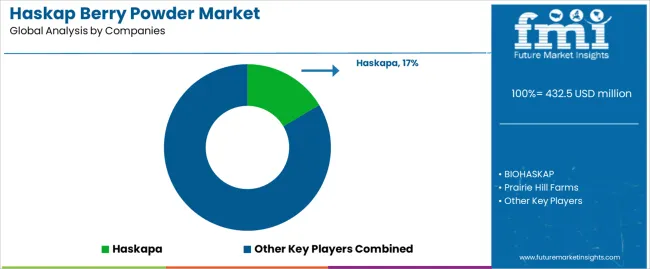
The haskap berry powder market operates with moderate concentration, featuring approximately 12-18 participants, where leading companies control roughly 38-44% of the global market share through established processing networks and comprehensive product portfolio capabilities. Competition emphasizes bioactive preservation, extraction consistency, and cost efficiency rather than premium feature rivalry.
Market leaders encompass Haskapa, BIOHASKAP, and Prairie Hill Farms, which maintain competitive advantages through extensive superfruit processing expertise, global distribution networks, and comprehensive technical support capabilities that create manufacturer loyalty and support health product requirements. These companies leverage decades of berry processing experience and ongoing extraction technology investments to develop advanced haskap powder systems with exceptional antioxidant and bioactive features.
Specialty challengers include Phytimpact, Vigorous-tech, and Jilin Longze Biotechnology, which compete through specialized application innovation focus and efficient processing solutions that appeal to nutraceutical buyers seeking reliable potency formats and custom concentration flexibility. These companies differentiate through operational efficiency emphasis and specialized market focus.
Market dynamics favor participants that combine consistent bioactive performance with advanced processing support, including automated extraction and packaging capabilities. Competitive pressure intensifies as traditional fruit processors expand into superfruit powder systems. At the same time, specialized ingredient converters challenge established players through innovative extraction formulations and cost-effective production targeting emerging health segments.
| Item | Value |
|---|---|
| Quantitative Units | USD 432.5 million |
| Processing Type | Low-Ratio Extraction, High-Ratio Extraction, Freeze-Dried Processing, Spray-Dried |
| Application | Food, Health Products, Nutraceuticals, Cosmetics, Sports Nutrition, Others |
| Regions Covered | North America, Europe, Asia Pacific, Latin America, Middle East & Africa |
| Countries Covered | China, India, Germany, Brazil, USA, UK, Japan, and 25+ additional countries |
| Key Companies Profiled | Haskapa, BIOHASKAP, Prairie Hill Farms, Phytimpact, Vigorous-tech, Jilin Longze Biotechnology |
| Additional Attributes | Dollar sales by processing type and application categories, regional adoption trends across Asia Pacific, Europe, and North America, competitive landscape with superfruit processors and ingredient manufacturers, consumer preferences for bioactive content and antioxidant potency, integration with food manufacturing equipment and formulation systems, innovations in extraction technology and multi-stage processing systems, and development of specialized functional ingredients with enhanced bioavailability and nutritional profiles |
The global haskap berry powder market is estimated to be valued at USD 432.5 million in 2025.
The market size for the haskap berry powder market is projected to reach USD 610.1 million by 2035.
The haskap berry powder market is expected to grow at a 3.5% CAGR between 2025 and 2035.
The key product types in haskap berry powder market are low-ratio extraction, high-ratio extraction, freeze-dried processing and spray-dried.
In terms of application, food segment to command 61.0% share in the haskap berry powder market in 2025.






Full Research Suite comprises of:
Market outlook & trends analysis
Interviews & case studies
Strategic recommendations
Vendor profiles & capabilities analysis
5-year forecasts
8 regions and 60+ country-level data splits
Market segment data splits
12 months of continuous data updates
DELIVERED AS:
PDF EXCEL ONLINE
Berry Core Power Transformer Market Size and Share Forecast Outlook 2025 to 2035
Mulberry Market
Blueberry Extract Antioxidants Market Size and Share Forecast Outlook 2025 to 2035
Market Share Insights for Blueberry Ingredient Providers
Acai Berry Extracts Market Analysis - Size and Share Forecast Outlook 2025 to 2035
Acai Berry Market Size, Growth, and Forecast for 2025 to 2035
Strawberry Seed Oil Market Analysis by Application, End-use, Distribution channel and Region Through 2035
Elderberry Supplements Market Analysis by Form, End Use Industry, Distribution Channel and Region Through 2035
Boysenberry Market Size and Share Forecast Outlook 2025 to 2035
White Mulberry Leaves Extract Market Growth - Product Type & Form Insights
Organic Goji Berry Market
Rubus Idaeus (Raspberry) Seed Oil Market Analysis by Food, Pharmaceuticals and Medical, Personal care and Cosmetics and Others Through 2035
Rubus Idaeus (Raspberry) Seeds Market
Rubus Fructicosus (Blackberry) Seed Market Size and Share Forecast Outlook 2025 to 2035
Powdered Cellulose Market Analysis - Size, Share, and Forecast Outlook 2025 to 2035
Powdered Soft Drinks Market Size and Share Forecast Outlook 2025 to 2035
Powder Packing Machine Market Size and Share Forecast Outlook 2025 to 2035
Powder Dispenser Market Analysis by Product Type, Size, Dispensing Mode, End-use Industry, and Region through 2025 to 2035
Analysis and Growth Projections for Powder Induction and Dispersion Systems Business
Leading Providers & Market Share in Powder Packing Machines

Thank you!
You will receive an email from our Business Development Manager. Please be sure to check your SPAM/JUNK folder too.
Chat With
MaRIA